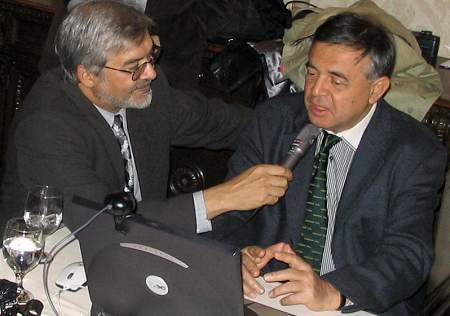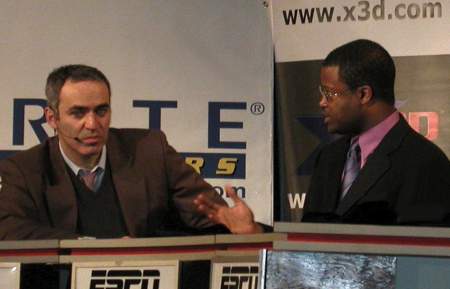Game two of the Man-Machine World Chess Championship opened with fanfare. New
York Rangers ice hockey star Anson Carter made the ceremonial first move for
Garry Kasparov, who had the black pieces against X3D Fritz. Instead of moving
a piece, he spoke into the voice recognition microphone. "e7 to e5"
he intoned, and the fight was on.

Premonition? A slightly grim Garry Kasparov enters for game two
The number 13 has long brought luck to Garry Kasparov. He was born on April
13, 1963. He was the 13th World Chess Champion and he took the title in 1985
(8+5=13). Today on the 13th X3D Fritz was a black cat walking across the path
of the world number one.

Kasparov and New York Rangers hockey star Anson Carter don the X3D glasses
It was another exciting game, with X3D Fritz handling the virtual white pieces.
Kasparov didn't play his beloved Sicilian Defense after X3D Fritz opened with
1.e4. Instead he opted for 1...e5 and headed into the Berlin Defense of the
Ruy Lopez. It was no coincidence that Kramnik used this same defense successfully against an earlier version of Fritz in a game last year (and even used it successfully against Kasparov himself
in their 2000 world championship match).

A problem at the start of the game: the virtual chessboard was set with
the white pieces in front. ChessBase programmer Jeroen van den Belt changes
the board, while a distraught Kasparov looks on. Right arbiter Albert Vasser.
Kasparov hoped to emulate that success but the X3D Fritz team was ready. They
went into a more active sideline of the Berlin by playing 4.d3. That kept the
powerful queens on the board, a critical factor that makes it much harder for
the human to keep up with the calculations of the computer.
It didn't all go White's way, however. Kasparov still managed to get the sort
of closed, maneuvering position he was hoping for. When X3D Fritz closed the
center of the board with 10.d5 the commentators were of the opinion that it
had played into Kasparov's hands.

Closed positions with blocked pawns and little piece activity are considered
very hard for computers to play. Their brute force method of finding the best
move can't reach far enough to make subtle positional decisions. Meanwhile,
a Grandmaster can recognize the patterns from years of experience and slowly
bring his forces into optimal position.
At least that's the way it usually works. X3D Fritz surprised the pundits by
making good move after good move, the same moves suggested by the many top-level
human players in attendance. Australian #1 Ian Rogers proposed that X3D Fritz
had passed the chess Turing test, the point at which a computer becomes indistinguishable
from a human!

Fritz author Mathias Feist looking after his computers
Kasparov built up a powerful attacking position on the kingside and began to
slowly advance. X3D Fritz did the same on the other side of the board, the queenside.
It advanced its pawns to establish a bind and potential breakthrough. Whose
attack would arrive first?
The Grandmasters were divided. GM Rogers favored White's chances, especially
since every piece exchange would favor X3D Fritz in the endgame. French #1 Joel
Lautier thought that Kasparov could build up enough pressure to hold back the
computer's pawns, and could even play for an advantage. ESPN2 commentator GM
Yasser Seirawan thought X3D Fritz had defended itself well on the kingside and
could look forward to winning chances with its queenside pawns.

The Internet corner, where Frans Morsch is being interviewed for the Playchess
server by Fred Friedel, while Jeroen van den Belt looks after the Fritz
media system technology. On the right Mig Greengard doing the live internet
coverage on multiple giant web portals.
Just as the tension was building to the breaking point, the computer blinked.
Instead of building up more pressure, it swapped pawns in the center with 28.cxd6,
letting go of much of its advantage on the left flank. It continued to liquidate
on that side and now it was more of a question of whether or not Kasparov would
be able to make any progress on the kingside where his forces were marshaled.

Interviewing US women's champion Anna Hahn on the Playchess server
That question went unanswered. At move 40 both players would get an extra hour
added to their clocks, but with only a dozen minutes left on his clock for the
next eight moves, Kasparov played hastily with 32...Rg7. It was intended to
prepare the aggressive advance of his kingside pawns. Unfortunately this move
was a fatal, and all too human, blunder.

Former US women's champ IM Jenny Shahade talking to ChessBase
Internet commentator Mig Greengard immediately typed out "Kasparov has
blundered!" to the hundreds of thousands of online viewers around the world.
In his hurry to make the final moves to the time control Kasparov had overlooked
a relatively simple pin tactic that allowed X3D Fritz to play a crushing attacking
move with 33.Rxe5.

GM Lev Alburt, many-time US Champion, discusses the game on Playchess.com
Kasparov himself was aware of his tragic error almost immediately. With no
opponent to hide his frustration from he got up from the board shaking his head
in anger. He stormed around the room, waiting for X3D Fritz to deliver the deadly
blow he knew was coming. He didn't have long to wait. A few moves later it was
clear that it was indeed as bad as we had thought.
Fritz X3D,( - Kasparov,G (2830) [C66]
New York (2), 13.11.2003

In time trouble Kasparov played 32...Rg7?? Fritz pounced
on the chance with 33.Rxe5. The rook on f8 is undefended and
the pawn on d6 pinned. The game ended 33...dxe5 34.Qxf8 Nd4 35.Bxd4
exd4 36.Re8 Rg8 37.Qe7+ Rg7 38.Qd8 Rg8 39.Qd7+ 1-0.
A rattled and defeated Kasparov played on listlessly in a position that at
first a few commentators thought might hold out chances for a draw. But it was
exactly the sort of tactical attacking position that computer play perfectly,
so the loss of a pawn was the least of Kasparov's problem. His king came under
a direct attack by X3D Fritz's queen and rook and the end was near.

An exhausted and deeply disappointed Garry Kasparov talks to GM Maurice
Ashley on ESPN immediately after the match.
Kasparov resigned on move 39. What he had already seen was now painfully obvious.
X3D Fritz would grab more pawns and push them down the board where they would
promote to new queens. It was hopeless. After over three hours of close battle
Kasparov had slipped just once and was punished mercilessly by the machine.

After the game an emotional Kasparov acknowledged that this is exactly the
problem with facing a beast like X3D Fritz. It may not play perfectly, and in
fact had missed its best chances, but it never made a serious mistake. On the
other hand a human, even Garry Kasparov, is vulnerable to oversights that the
computer will punish instantly.
There are only two games left for Kasparov to strike back and even the score.
Game three is Sunday so he has two days to recover from this brutal blow to
his ego and his concentration. Can he come back? He will have the advantage
of the white pieces in game three.
Replay the annotated game here
Report by Mig Greengard
Pictures by Frederic Friedel, Mig Greengard, Susan Grumer



































